


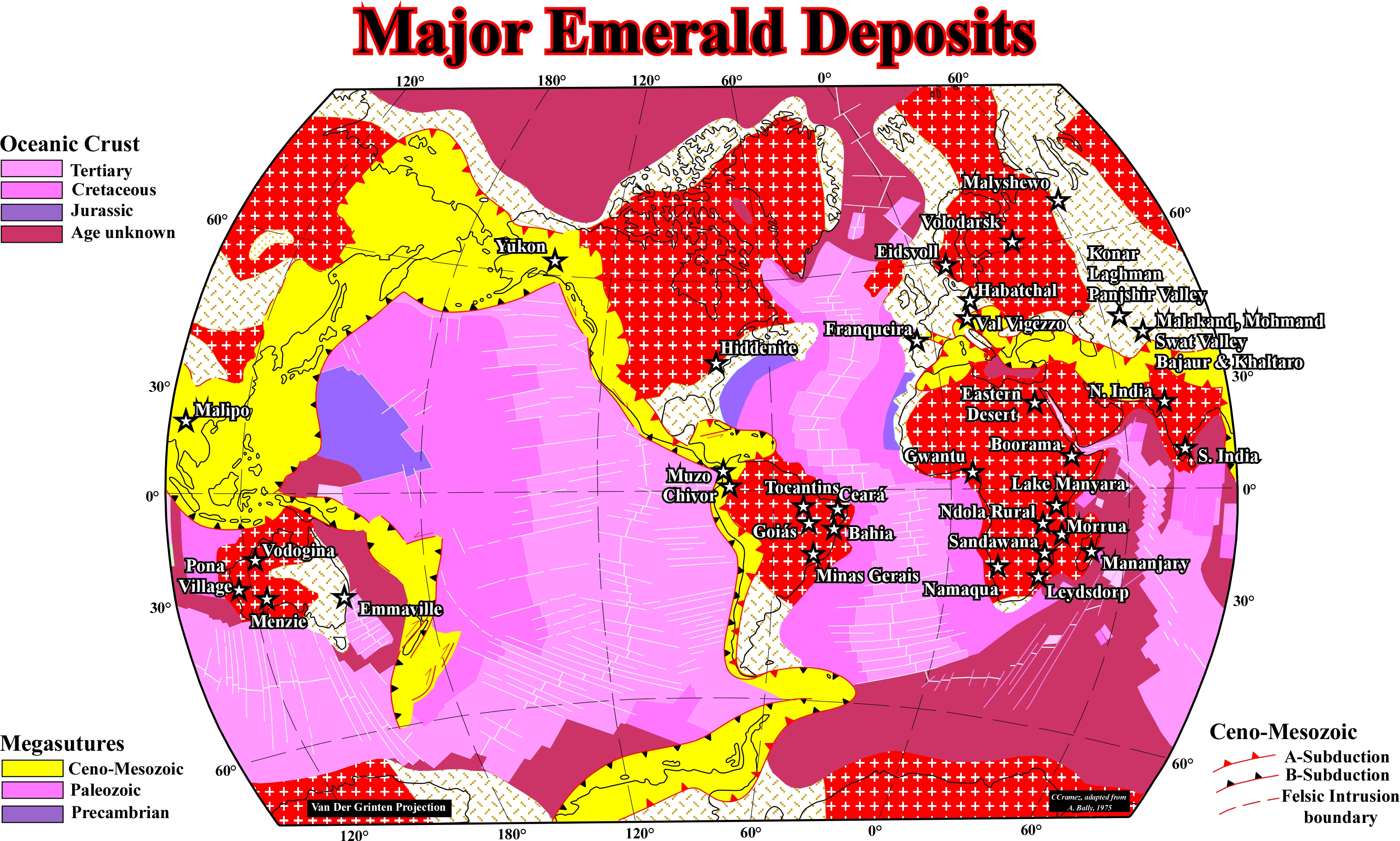
Emerald deposits were formed always in association with the formation of megasutures. The oldest emerald deposit seems to be Leydsdorp (Gravelotte mine, in South Africa). Its age is around 3 Ga. The age of emeralds in Bahia (Brazil) is around 2 Ga, while in Minas Gerais (Brazil), the age is around 0.6 Ma. Just four major deposits are associated with the Ceno-Mesozoic megasuture : Malipo (Yunnan, Chine), Yukon (Canada), Muzo belt and Chivor belt (onshore Colombia). The Chivor emeralds are older (65 Ma) than in Muzo (40 Ma). The large majority of the emerald deposits are Type I, that is to say, associated with granitic intrusions (presence or not of biotite shales). The Colombian deposits are not associated with granitic rocks. They are Type II, since the mineralization, into Cretaceous calcareous black shales, is controlled by tectonic structures (thrusts, reverse and strike-slips faults developed during a major tectonic inversion). In other words, a successful exploration and (particularly) mining production of the Colombian deposits requires exhaustive structural studies at macro and mesoscopic scales.
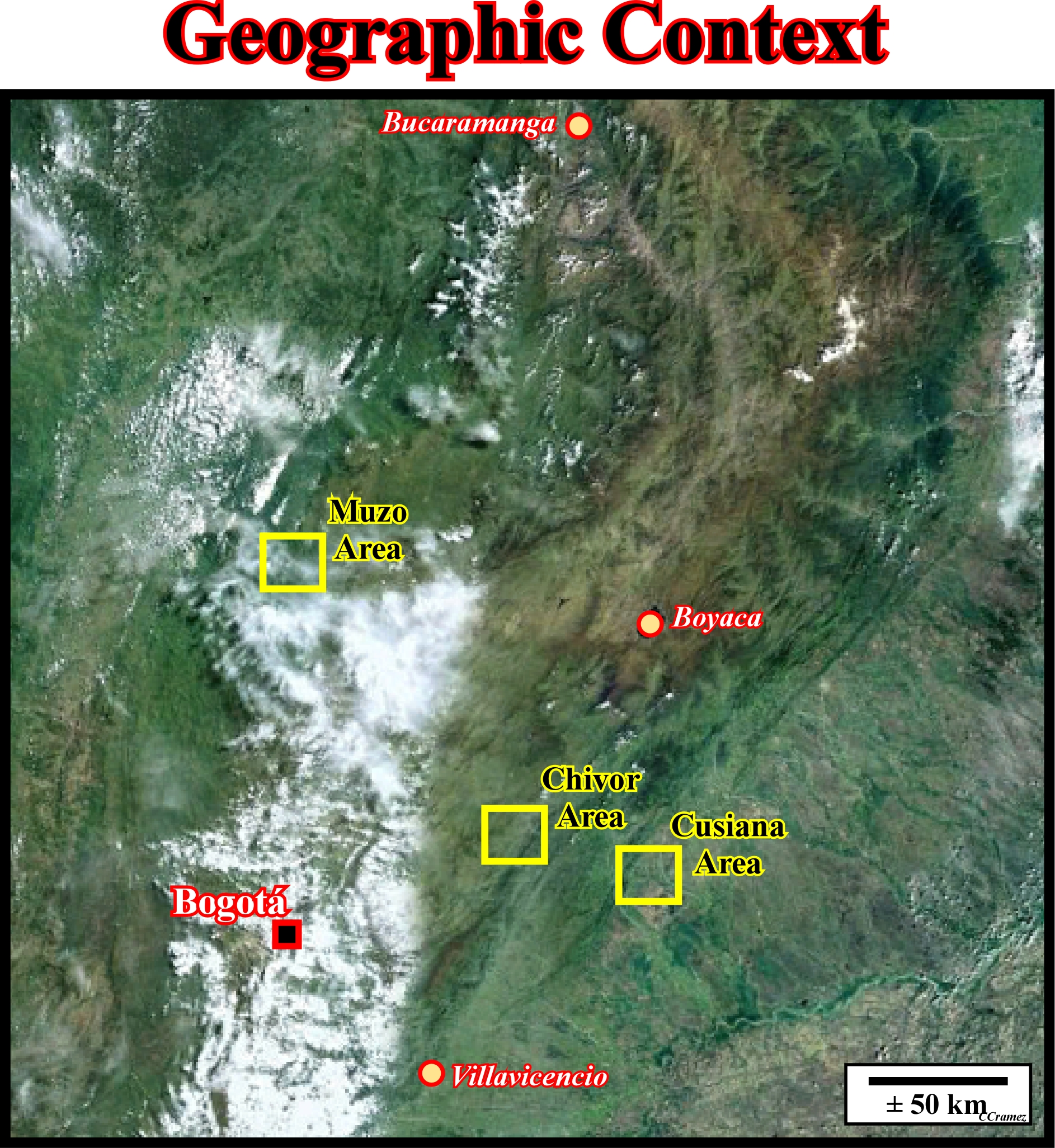
The sedimentary shortening associated with the formation of the Ceno-Mesozoic megasuture (mobile folded-faulted belt of the Earth, underlying the complexity of the accretion-deformation phases supported by the geological bodies under compressional tectonic regimes), not only created petroleum structural traps (Cusiana, for instance), but an emerald-forming hydrothermalism (Muzo, Coscuez, Chivor mines, etc.), as well. A successful petroleum or emerald exploration-production is strongly dependent on the understanding of the tectonic of the Colombian Cordilleras and Llanos foredeep.
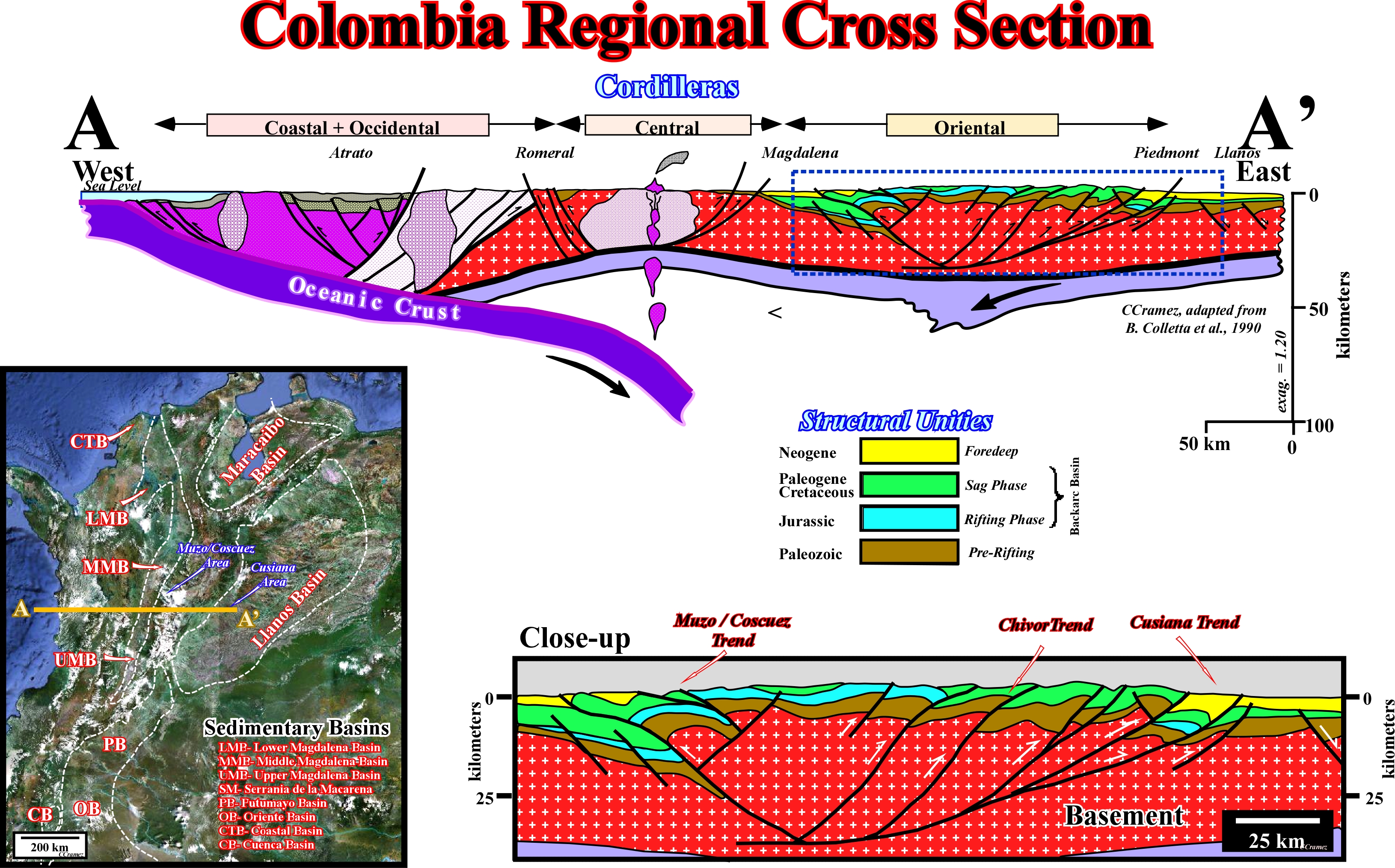
This regional schematic cross-section between the Llanos foredeep and the present forearc basin illustrates the sedimentary shortening and the tectonic inversion occurring during the formation of the Ceno-Mesozoic megasuture, in the northern part of South America. The Colombian Cordilleras (Occidental, Central and Oriental) seem to be the result of an Upper Miocene tectonic inversion of a Trias - Paleogene basin, which seems start, in the Late Eocene, with reactivation of the old rifting normal faults (rifting phase of the backarc basin). Such reactivation developed thrusts, duplexes, reverse and strike-slip faults. The tectonic inversion took place in different shortening episodes. It is accompanied by an emerald-forming hydrothermalism (Muzo - Coscuez and Chivor), i. e., by emanations of hot water that are rich in minerals (Be, Cr, V, Si, Al). The Oriental Cordillera emerald deposits are hosted in Lower Cretaceous sediments (calcareous black shales named here carbonaceous calsiltites), which cored long anticline structures trending NNE-SSW.

This tentative interpretation of a seismic line through the first significant structural traps in Santiago de las Attalayas block (Cusiana field) illustrates de sedimentary shortening by folding and faulting in the piedmont (Llanos sediments are practically undeformed). The Cretaceous organic rich rocks (source-rocks), here, are not equivalent the black carbonate shales of Muzo - Coscuez and Chivor areas, which contain emerald mineralization in carbonate-pyrite veins and breccia. Taking into account the petroleum exploration results, in this area, the Cretaceous sediments never reached the depth of formation of emerald (4250 - 4500 m or ± 360° C). Subsequently, hydrocarbons were generated and migrated along fault plans and reservoirs (toward potential traps). In Muzo - Coscuez and Chivor areas, hydrothermal fluids form calcite veins, in Lower cretaceous sediments (they do not exist in Cusiana area), which, later, were deformed and mineralized by emerald and other minerals.
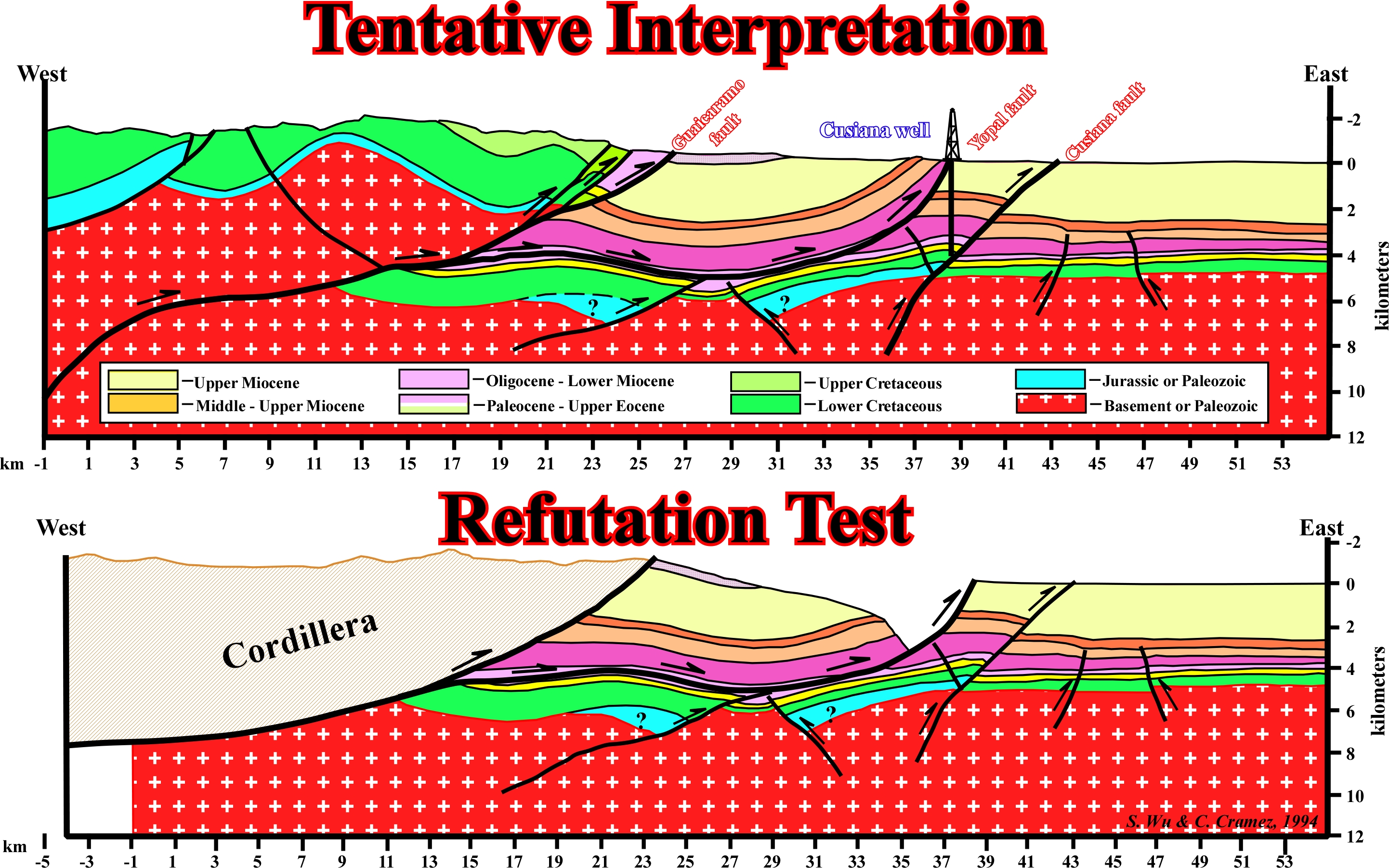
The Cordillera is ignored since many parameters are not controlled. The refutation test of the proposed tentative geological interpretation failed, that is to say the tentative interpretation is not refuted by a balancing test. The following features can be advanced : (1) At this stage (post Late Miocene), all faults show reverse geometry ; (2) The synform on the hangingwall of Yopal fault is above the regional level ; (3) The Jurassic - Early Cretaceous extension can be interpreted as the rifting phase of the back-arc basin ; (4) Early Cretaceous sediments are just present in the Cordillera ; (5) The sag phase is almost isopachous (slightly thickening westward) until Early - Middle Miocene ; (6) A Early - Middle Miocene foredeep took place and its eastward thinning suggests a continuous shortening ; (7) Different compressional phases are recognized with an eastward, in sequence, thrust propagation until the erosion on the highland release the geostatic pressure reactivating the rifting normal fault with formation of a huge inverted structures, which form the Eastern Cordillera. When temperature reaches 300-360° (burial and / or additional input), which seems to be the case in deep part of the basin (Eastern and Central Cordillera), the deep-seated reactivated faults allow hot-fluid circulation up through sedimentary column. On the other hand, hydrofracturing and strongly reducing conditions, highly favored by the presence of Early Cretaceous black shales (see next plate), provoking emerald-pyrite-calcite precipitation.
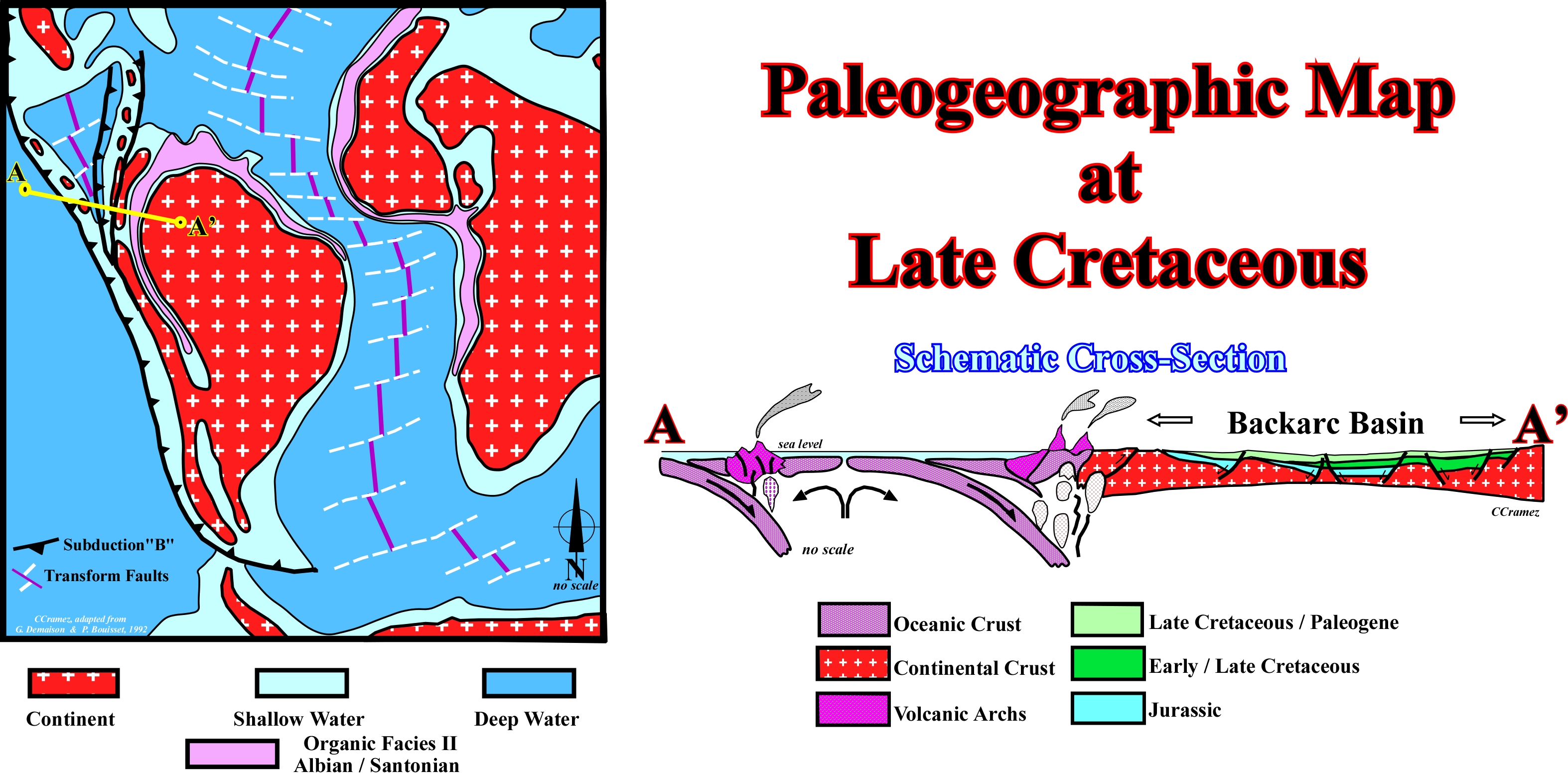
In this Late Cretaceous paleogeographic map and particularly in the schematic cross section, it is easy to see the strike and structure of the Mesozoic backarc basin induced by the Benioff (type B) subduction zone, in which the Pacific and Caribbean oceanic plates plunge under the South America continental plate. At that time, before the Late Tertiary tectonic inversion, induced mainly by reactivation of the pre-existent normal faults developed during the rifting phase, the Jurassic and Early Cretaceous half-grabens (generally with opposite vergence) underline a maximal subsidence, in the central part of the basin (Lower Cretaceous sediments are absent under the present foreland basin) and restrict anoxic geological conditions, which have favored deposition and preservation of organic rich sediments. Such a conditions favor a Jurassic - Early Cretaceous salt deposition by percolation from deep basinal formation waters during the ore-forming hydrothermal process Giuliani et al., 1992). However, up to this date, there is no evidence of evaporites in Eastern Cordillera. On the contrary, salt diapirs are known to intrude Upper Cretaceous sediments in the Sabana of Bogota (Zipaquirá and Nemocon mines) and Lower Cretaceous sediments in the eastern emerald zone. The eventually presence of evaporitic layers and salt domes can significantly increase the burial temperature (around 135°) to around 300° C (emerald generation) and enrich the brines favoring emerald deposits, which are mesothermal deposits (300° C) formed in sedimentary environment and produced through thermochemical reduction of sulphate-rich brines to hydrogen sulphide by interaction with organic-rich strata (G. Guiliani et al., 1995).
 GoNext
GoNext
Send E-mail to carloscramez@gmail.com with questions or comments about these notes .
Copyright © 2012 CCramez
Last modification: December, 2014